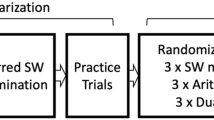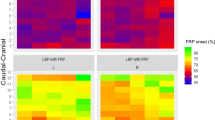Abstract
In chronic low back pain patients (CLBP), neuromuscular and pain intensity have been identified as contributing factors in the disability of the individual. However, it is unclear whether pain intensity influences neuromuscular activation and if directed attention mediates this relationship. Thus, the purpose of this study was to determine the effect of directed attention in individuals with different pain intensities on back extensor activation profiles. Fifty-four CLBP patients were separated into either high- or low-pain groups. Surface electromyograms were recorded from back muscles while the subjects performed a trunk flexion motion for four different attention conditions. Pattern recognition and repeated measures ANOVAs were used to examine the effect of sex, attention and pain intensity on temporal muscle activation patterns. The results showed that there was a significant sex × attention × pain interaction. The largest changes in muscle timing were observed in the low-pain group when their attention was focused on their pain, but the pattern of muscle activation differed between sexes. For males, a rapid decline in activation at mid-extension occurred, whereas females showed delayed activation at the beginning of extension. Overall, this study demonstrated that directed attention on pain had an effect on trunk muscle temporal recruitment, and that this relationship differed between sexes and pain groups. This suggests that sex-specific mechanisms may alter the neuromuscular control of the spine in CLBP patients for different pain levels.




Similar content being viewed by others
References
Astephen JL, Deluzio KJ, Caldwell GE, Dunbar MJ, Hubley-Kozey CL (2008) Gait and neuromuscular pattern changes are associated with differences in knee osteoarthritis severity levels. J Biomech 41:868–876
Bingefors K, Isacson D (2004) Epidemiology, co-morbidity, and impact on health-related quality of life of self-reported headache and musculoskeletal pain—a gender perspective. Eur J Pain 8:435–450
Burns JW (2006) The role of attentional strategies in moderating links between acute pain induction and subsequent psychological stress: evidence for symptom-specific reactivity among patients with chronic pain versus healthy nonpatients. Emotion 6:180–192
Bushnell MC, Villemure C, Duncan GH (2004) Psychophysical and neurophysiological studies of pain modulation by attention. In: Price DD, Bushnell MC (eds) Psychological methods of pain control: basic science and clinical perspectives. IASP Press, Seattle, pp 99–116
Butler HL, Newell R, Hubley-Kozey CL, Kozey JW (2009) The interpretation of abdominal wall muscle recruitment strategies change when the electrocardiogram (ECG) is removed from the electromyogram (EMG). J Electromyogr Kinesiol 19:e102–e113
Callaghan JP, Dunk NM (2002) Examination of the flexion relaxation phenomenon in erector spinae muscles during short duration slumped sitting. Clin Biomech 17:353–360
Corbeil P, Blouin JS, Teasdale N (2004) Effects of intensity and locus of painful stimulation on postural stability. Pain 108:43–50
Dagenais S, Caro J, Haldeman S (2008) A systematic review of low back pain cost of illness studies in the United States and internationally. Spine J 8:8–20
Eccleston C (1995) Chronic pain and distraction: an experimental investigation into the role of sustained and shifting attention in the processing of chronic persistent pain. Behav Res Ther 33:391–405
Falla D, Arendt-Nielsen L, Farina D (2008) Gender-specific adaptations of upper trapezius muscle activity to acute nociceptive stimulation. Pain 138:217–225
Falla D, Farina D (2008) Neuromuscular adaptation in experimental and clinical neck pain. J Electromyogr Kinesiol 18:255–261
Fillingim RB, King CD, Ribeiro-Dasilva MC, Rahim-Williams B, Riley JL 3rd (2009) Sex, gender, and pain: a review of recent clinical and experimental findings. J Pain 10:447–485
Freburger JK, Holmes GM, Agans RP, Jackman AM, Darter JD, Wallace AS, Castel LD, Kalsbeek WD, Carey TS (2009) The rising prevalence of chronic low back pain. Arch Intern Med 169:251–258
Gazerani P, Wang K, Cairns BE, Svensson P, Arendt-Nielsen L (2006) Effects of subcutaneous administration of glutamate on pain, sensitization and vasomotor responses in healthy men and women. Pain 124:338–348
Ge HY, Madeleine P, Arendt-Nielsen L (2004) Sex differences in temporal characteristics of descending inhibitory control: an evaluation using repeated bilateral experimental induction of muscle pain. Pain 110:72–78
Ge HY, Arendt-Nielsen L, Farina D, Madeleine P (2005) Gender-specific differences in electromyographic changes and perceived pain induced by experimental muscle pain during sustained contractions of the upper trapezius muscle. Muscle Nerve 32:726–733
Ge HY, Madeleine P, Cairns BE, Arendt-Nielsen L (2006) Hypoalgesia in the referred pain areas after bilateral injections of hypertonic saline into the trapezius muscles of men and women: a potential experimental model of gender-specific differences. Clin J Pain 22:37–44
George SZ, Wittmer VT, Fillingim RB, Robinson ME (2007) Sex and pain-related psychological variables are associated with thermal pain sensitivity for patients with chronic low back pain. J Pain 8:2–10
Goubert L, Crombez G, Eccleston C, Devulder J (2004) Distraction from chronic pain during a pain-inducing activity is associated with greater post-activity pain. Pain 110:220–227
Greenspan JD, Craft RM, LeResche L, Arendt-Nielsen L, Berkley KJ, Fillingim RB, Gold MS, Holdcroft A, Lautenbacher S, Mayer EA, Mogil JS, Murphy AZ, Traub RJ, Consensus Working Group of the Sex, Gender, Pain SIG of the IASP (2007) Studying sex and gender differences in pain and analgesia: a consensus report. Pain 132(Suppl 1):S26–S45
Hansson GA, Asterland P, Holmer NG, Skerfving S (2001) Validity and reliability of triaxial accelerometers for inclinometry in posture analysis. Med Biol Eng Comput 39:405–413
Hodges PW, Moseley GL, Gabrielsson A, Gandevia SC (2003) Experimental muscle pain changes feedforward postural responses of the trunk muscles. Exp Brain Res 151:262–271
Hodges PW, Ervilha UF, Graven-Nielsen T (2008) Changes in motor unit firing rate in synergist muscles cannot explain the maintenance of force during constant force painful contractions. J Pain 9:1169–1174
Hubley-Kozey CL, Vezina MJ (2002) Differentiating temporal electromyographic waveforms between those with chronic low back pain and healthy controls. Clin Biomech 17:621–629
Hubley-Kozey CL, Deluzio KJ, Landry SC, McNutt JS, Stanish WD (2006) Neuromuscular alterations during walking in persons with moderate knee osteoarthritis. J Electromyogr Kinesiol 16:365–378
Hurley RW, Adams MC (2008) Sex, gender, and pain: an overview of a complex field. Anesth Analg 107:309–317
Jackson JE (2003) A user’s guide to principal components. Wiley, Hoboken
Kewman DG, Vaishampayan N, Zald D, Han B (1991) Cognitive impairment in musculoskeletal pain patients. Int J Psychiatry Med 21:253–262
Kori SH, Miller RP, Todd DD (1990) Kinisophobia: a new view of chronic pain behavior. Pain Manage 3:35–43
Kovacs FM, Abraira V, Zamora J, Fernandez C, Spanish Back Pain Research Network (2005) The transition from acute to subacute and chronic low back pain: a study based on determinants of quality of life and prediction of chronic disability. Spine 30:1786–1792
Lamoth CJ, Stins JF, Pont M, Kerckhoff F, Beek PJ (2008) Effects of attention on the control of locomotion in individuals with chronic low back pain. J Neuroeng Rehabil 5:13
Lariviere C, Arsenault AB, Gravel D, Gagnon D, Loisel P (2001) Median frequency of the electromyographic signal: effect of time-window location on brief step contractions. J Electromyogr Kinesiol 11:65–71
Lotters F, Burdorf A (2006) Prognostic factors for duration of sickness absence due to musculoskeletal disorders. Clin J Pain 22:212–221
Marras WS, Davis KG, Heaney CA, Maronitis AB, Allread WG (2000) The influence of psychosocial stress, gender, and personality on mechanical loading of the lumbar spine. Spine 25:3045–3054
Moseley GL, Nicholas MK, Hodges PW (2004) Pain differs from non-painful attention-demanding or stressful tasks in its effect on postural control patterns of trunk muscles. Exp Brain Res 156:64–71
Moseley GL, Hodges PW (2006) Reduced variability of postural strategy prevents normalization of motor changes induced by back pain: a risk factor for chronic trouble? Behav Neurosci 120:474–476
Nouwen A, Cloutier C, Kappas A, Warbrick T, Sheffield D (2006) Effects of focusing and distraction on cold pressor-induced pain in chronic back pain patients and control subjects. J Pain 7:62–71
Ostelo RW, Deyo RA, Stratford P, Waddell G, Croft P, Von Korff M, Bouter LM, de Vet HC (2008) Interpreting change scores for pain and functional status in low back pain: towards international consensus regarding minimal important change. Spine 33:90–94
O’Sullivan P, Dankaerts W, Burnett A, Chen D, Booth R, Carlsen C, Schultz A (2006) Evaluation of the flexion relaxation phenomenon of the trunk muscles in sitting. Spine 31:2009–2016
Panjabi MM (2006) A hypothesis of chronic back pain: ligament subfailure injuries lead to muscle control dysfunction. Eur Spine J 15:668–676
Passatore M, Roatta S (2006) Influence of sympathetic nervous system on sensorimotor function: whiplash associated disorders (WAD) as a model. Eur J Appl Physiol 98:423–449
Quiton RL, Greenspan JD (2007) Sex differences in endogenous pain modulation by distracting and painful conditioning stimulation. Pain 132(Suppl 1):S134–S149
Roland M, Morris R (1983) A study of the natural history of back pain. Part I: development of a reliable and sensitive measure of disability in low-back pain. Spine 8:141–144
Rollman GB, Lautenbacher S (2001) Sex differences in musculoskeletal pain. Clin J Pain 17:20–24
Schneider S, Randoll D, Buchner M (2006) Why do women have back pain more than men? A representative prevalence study in the federal republic of Germany. Clin J Pain 22:738–747
Seminowicz DA, Davis KD (2007) A re-examination of pain-cognition interactions: implications for neuroimaging. Pain 130:8–13. doi:10.1016/j.pain.2007.03.036
Solomonow M (2009) Ligaments: a source of musculoskeletal disorders. J Bodyw Mov Ther 13:136–154
Spitzer WO, LeBlanc F, Dupuis M (1987) A scientific approach to the assessment and management of activity-related spinal disorders: a monograph for clinicians. Spine 12(Supp 75):S3–S59
Suissa S (2003) Risk factors of poor prognosis after whiplash injury. Pain Res Manage 8:69–75
Sullivan MJ, Bishop S, Pivik J (1995) The pain catastrophizing scale: development and validation. Psychol Assess 7:524–532
Sullivan MJ, Thibault P, Savard A, Catchlove R, Kozey J, Stanish WD (2006) The influence of communication goals and physical demands on different dimensions of pain behavior. Pain 125:270–277
Sullivan MJ (2008) Toward a biopsychomotor conceptualization of pain: implications for research and intervention. Clin J Pain 24:281–290
Thomas E, Silman AJ, Croft PR, Papageorgiou AC, Jayson MI, Macfarlane GJ (1999) Predicting who develops chronic low back pain in primary care: a prospective study. BMJ 318:1662–1667
Van Dieen JH (2007) Low-back pain and motor behavior: contingent adaptations, a common goal. Sixth interdisciplinary world congress on low back and pelvic pain, Barcelona, pp 3–14
van Dieen JH, Cholewicki J, Radebold A (2003) Trunk muscle recruitment patterns in patients with low back pain enhance the stability of the lumbar spine. Spine 28:834–841
Von Korff M, Miglioretti DL (2005) A prognostic approach to defining chronic pain. Pain 117:304–313
Waddell G, Somerville D, Henderson I, Newton M (1992) Objective clinical evaluation of physical impairment in chronic low back pain. Spine 17:617–628
Waersted M (2000) Human muscle activity related to non-biomechanical factors in the workplace. Eur J Appl Physiol 83:151–158
Walker J (1971) Pain and distraction in athletes and non-athletes. Percept Mot Skills 33:1187–1190
Winter DA (2005) Biomechanics and motor control of human movement. Wiley, Hoboken
Acknowledgments
We wish to thank the Quebec Rehabilitation Research Network and the Occupational Health and Safety Research Institute Robert-Sauvé for their financial support.
Author information
Authors and Affiliations
Corresponding author
Rights and permissions
About this article
Cite this article
Butler, H.L., Lariviere, C., Hubley-Kozey, C.L. et al. Directed attention alters the temporal activation patterns of back extensors during trunk flexion–extension in individuals with chronic low back pain. Eur Spine J 19, 1508–1516 (2010). https://doi.org/10.1007/s00586-010-1403-0
Received:
Revised:
Accepted:
Published:
Issue Date:
DOI: https://doi.org/10.1007/s00586-010-1403-0




